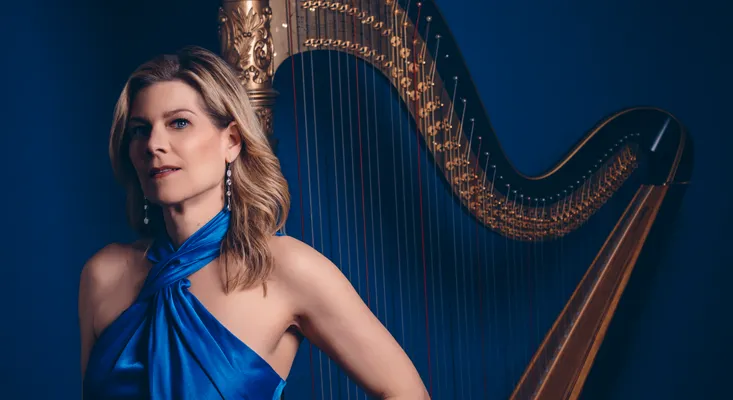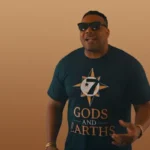
Relaxing harp music takes center stage as world-renowned, Grammy-nominated artist Kirsten Agresta Copely shares ‘Kuruvinda,’ an album where ancient ruby symbolism turns into captivating, healing melodies. Don’t miss this exclusive interview and learn how she brings it all to life!
1. Do you remember the first time you touched a harp and felt hooked — and why harp instead of piano, guitar, or another instrument?
I remember I was only five years old when I first touched a harp. My mother introduced me to the instrument, and from the moment I felt the strings under my fingers, I knew it was something special. I also play piano and have always felt strongly about both, but the harp has given me rare opportunities that I could have never imagined with a different instrument.
2. Your Grammy-nominated album was called ‘Aquamarine,’ now you’ve released ‘Kuruvinda’ (Sanskrit for ruby). What drew you from one gemstone to another?
I see ‘Aquamarine’ and ‘Kuruvinda’ as companion gems in a larger story. ‘Aquamarine’ was about fluidity, stages of grief, and healing — things that flow like water. But after that, I found myself drawn to what is more internal and explored deeper beneath the surface.
‘Kuruvinda’ feels a bit more intense musically. It’s the duality and balance between shadow and light – about honoring our imperfections and accepting that our cracks are part of our brilliance. I feel like this album is an evolution, shifting from healing water to warm fire, from external landscapes to inner jewels.
3. If I’m not mistaken, ruby stones symbolize passion, protection, and vitality. How did you translate that into relaxing harp music?
That’s true in the literal translation of the word; however, this music represents the more spiritual side of the gem. ‘Kuruvinda’ can be translated to a “flawed but radiant ruby,” and there’s a quiet intensity to this album that comes through, using the full range of the harp from high shimmers to thunderous lows. I hope that this music feels like a breath of calm in a noisy world.
4. Do you enter a meditative state when playing? How does creating relaxing music influence your harp technique?
When I’m composing, the music needs to bring me into a place of meditation, peace, or relaxation. That means I need to let notes breathe, to listen to resonances, and allow the music to flow. Technique-wise, playing relaxing music often means more control of touch and simplifying rather than embellishing.
5. Is this album designed for meditation, yoga, healing, or helping people relax and unwind?
‘Kuruvinda’ absolutely embraces those uses! But I don’t think of it only as background or ambient music. It’s meant to offer a space: for meditation, for reflection, for healing, for just a pause. I hope people use it as a companion in yoga, in baths, in long, quiet drives, as well as in deep listening.
6. Did you collaborate with other musicians in the studio, or is this purely your solo harp work?
The harp is always the anchor, but I also worked with some amazing musicians to add texture and emotional color to several pieces. For instance, on “Ratnaraja,” Ismail Lumanovski plays G-clarinet, which adds a subtle, mystical layer to the duet. Jessica Meyer (viola) and Dave Eggar (cello) contribute warm strings on “Intertwined” and “Untold Story.”
7. Which track surprised you most during the recording process? Why?
One of the tracks that surprised me was “Ratnaraja.” Working with Ismail, I didn’t fully know where the dialogue between the harp and the clarinet would take us. The clarinet’s voice felt like something I dreamed of, and in the studio, it really unfolded in a way that felt haunting, mystical, and resonant.

8. Are you super protective of your hands, like an athlete with their muscles?
My hands are my instruments in more ways than one. It’s important to keep them protected from injury, but also from the cold weather in winter. Harpists need to have callouses on our fingers, but still keep our hands moisturized. I also have a series of stretches that I do to keep my fingers limber. But they’re not insured, which is a common question!
9. Where would you love to hear these relaxing songs played that would surprise people? Spas, wellness centers, or somewhere totally unexpected?
I’d love to hear ‘Kuruvinda’ in unexpected spaces — maybe in an observatory during a star-gazing event, or on a boat at twilight, or in a modern art space. Spas and wellness centers are perfect for this music, but places that shift the way we normally encounter harp music are especially thrilling to imagine.
10. What’s next? Are you already composing your follow-up?
Let’s just say ‘Kuruvinda’ still feels like it has more to reveal, even to me. I’m letting this album linger before deciding where to go next. There are sketches and whispers of ideas, but I’m not rushing them. The beauty of imperfection—and of creation—is letting the next chapter reveal itself when it’s ready.
CONNECT WITH KIRSTEN AGRESTA COPELY
YouTube | Facebook | Instagram
Hi, I’m Erick Ycaza — a music blogger with a BA in Advertising & Graphic Design. I created this blog to keep you updated with daily music news. Surprisingly, I’ve been writing about music since 2007. If you’re an artist and would like to be featured, feel free to reach out: info@electrowow.net







